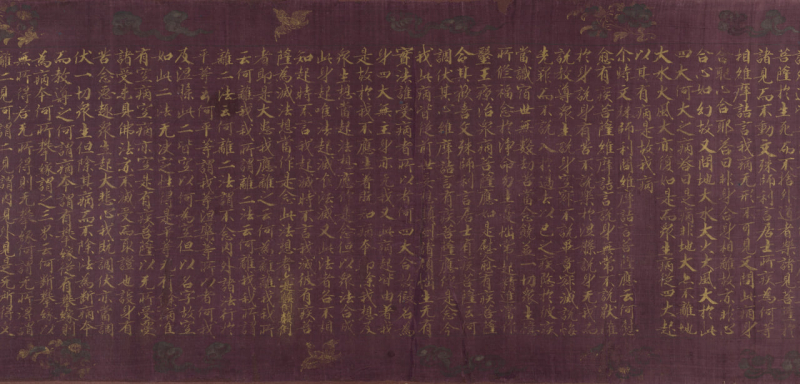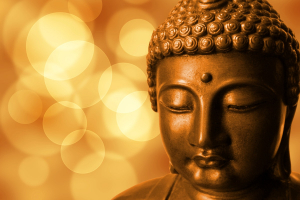Top 10 Most Famous Sutras in Mahayana Buddhism
The ten most famous sutras in Mahayana Buddhism encompass a collection of profound scriptures that have shaped this tradition's philosophical and spiritual ... read more...landscape. These sutras, revered for their teachings on compassion, wisdom, and the path to enlightenment, hold a special place in the hearts of Mahayana practitioners. Let's delve into these timeless texts to explore their significance and wisdom in the realm of Mahayana Buddhism.
-
The Prajnaparamita Hridaya Sutra, commonly known as the Heart Sutra, is one of the most well-known teachings in Mahayana Buddhism. It's part of a more extensive collection of teachings called the Heart Scripture literature, which explores the idea of empty things and the fundamental reality of everything. The sutra has only 14 short parts and is like a conversation between Shariputra and Avalokiteshvara.
The Prajnaparamita Hridaya Sutra says that everything practitioners see doesn't exist independently. It says that the way things look is like how emptiness looks, and the way emptiness is, is like how things look. This helps people think beyond their usual thinking and understand that everything is connected. At the end of the sutra, there's a special saying that shows what the sutra is the mantra. This saying is often repeated during Buddhist practices.
Even though the Prajnaparamita Hridaya Sutra is short, it's famous for being simply profound, quickly explaining complicated ideas. Many intelligent people and people who follow Buddhism have discussed it to understand it better. The Heart Sutra is essential to many Buddhist groups, especially in East Asia. People often say or sing it to become wiser, and its ideas have influenced the main ideas of different types of Buddhism.
The Prajnaparamita Hridaya Sutra, or Heart Sutra, is a small but powerful teaching in Mahayana Buddhism. It talks about emptiness, wisdom, and how things are all connected. It came from early Mahayana India, and it's set up like a conversation with a special saying at the end. People from different times and places find it interesting, and it encourages them to explore its profound ideas.

Photo on Wikimedia Commons (https://commons.wikimedia.org/wiki/File:013_The_Heart_Sutra_%2824267027697%29.jpg) Video by 邵宛妤 -
The Diamond Sutra, also known as the Vajracchedika Prajnaparamita Sutra, is very well-known teaching in Mahayana Buddhism. It came from India a long time ago, between the 1st and 5th centuries. It's part of the Diamond Wisdom literature, which talks about things being empty and the genuine nature of everything. Like a conversation between the Buddha and his student Subhuti, this sutra carries teachings that challenge conventional understanding.
In The Diamond Sutra, the Buddha and Subhuti talk to each other. They talk about important ideas. One big picture is that things don't exist like practitioners usually think. The sutra also discusses how things are connected and how practitioners can learn better. It uses the word "diamond" to explain how wisdom is vital and can show practitioners the truth, like cutting through things that aren't real to find freedom.
People in different parts of Mahayana Buddhism like the Diamond Sutra a lot. It's also essential in Zen Buddhism, which likes understanding things directly. The sutra also stresses not to be too attached to something, which means not holding on too tightly. Many people have written and talked about this sutra throughout history, helping others understand its essential ideas.
The Vajracchedika Prajnaparamita Sutra is an essential part of Mahayana Buddhism. It came from India a long time ago. Emerging from ancient India, it enlightens practitioners about emptiness, skillful means, and non-attachment. Through its dialogue structure and metaphorical insights, it continues to guide seekers in transcending conventional understanding and delving into the nature of reality.

Photo on Wikimedia Commons (https://commons.wikimedia.org/wiki/File:Diamond_Sutra_of_868_AD_-_The_Diamond_Sutra_%28868%29,_frontispiece_and_text_-_BL_Or._8210-P.2.jpg) Video by Samaneri Jayasāra - Wisdom of the Masters -
The Sandhinirmocana Sutra is an essential book in Mahayana Buddhism called Yogacara or Cittamatra. It's like a guide that helps practitioners understand profound ideas about life. It came from India, maybe around the 2nd or 3rd century. Its name means "Sutra that Explains Very Important Meaning," showing it's about understanding Buddhist ideas that are hard to understand.
The Sandhinirmocana Sutra looks into what's real, thinking about how things are empty and how the world is like a trick. It's known for studying Buddha's teachings in a big way, putting them into three "turnings of the Dharma wheel". These lessons show how Buddhist ideas improved from simple concepts to good understanding.
The Sandhinirmocana Sutra explores the essence of reality, delving into the concept of emptiness and the illusory nature of the world. It also tells people who want to be good Buddhists, called bodhisattvas, how to become enlightened. It talks about what they should do and what they should be like.
The Sandhinirmocana Sutra greatly impacted the Yogacara school, which is all about understanding the mind and what's real. It's been translated into different languages, and many intelligent people have written about it. The Sandhinirmocana Sutra is like a light that helps people who follow Buddhism understand profound things and how to practice them in the Yogacara way.

Photo on Wikimedia Commons (https://commons.wikimedia.org/wiki/File:10th-century_manuscript_of_2nd-3rd_century_Prajnaparamita_stotra,_Mahayana_Buddhism_text,_Sanskrit,_Pala-Bengali-Nepali_scripts.jpg) Video by acalaacala -
The Lotus Sutra, also known as the Saddharma Pundarika Sutra, is an essential teaching in Mahayana Buddhism. It's like a light that shows practitioners intelligent ways of thinking and being kind. It started in India long ago, maybe between the 1st and 3rd centuries. It means "Book about the Lotus Flower of the Amazing Wisdom."
The Lotus Flower Wisdom Book talks about how to teach different people in different ways. The sutra uses stories that are easy to imagine and words that help practitioners understand better. It takes practitioners through additional layers of thinking until they know something important. The book talks about how all living things can become wise, no matter who they are.
The Lotus Flower Wisdom Book has been essential in many places where people follow Buddhism, especially in East Asia. It changed how people think about Pure Land Buddhism, Tiantai/Tendai Buddhism, and Nichiren Buddhism. People like its ideas about being kind and finding truths. Many intelligent people have talked about it and made it easier to understand, helping people who want to be wise.
So, the Lotus Sutra, or Lotus Flower Wisdom Book, is essential to Mahayana Buddhism. It started in India a long time ago and taught practitioners about intelligent ways of teaching, everyone becoming wise, and profound wisdom. Through its stories and its idea of togetherness, it helps people understand Buddhism better, no matter where they're from.

Photo on Wikimedia Commons Video by jbfoyle -
The Lankavatara Sutra, known as the Sutra of the Descent to Lanka, is a significant Mahayana Buddhist scripture valued for its philosophical depth and insight into the nature of reality and consciousness. Originating in India during the 4th or 5th century CE, this sutra is attributed to Mahamati and is pivotal in Zen and Yogacara traditions.
The Lankavatara Sutra deeply explores the mind and consciousness, unveiling layers of understanding about their intricate interplay. It introduces the concept of the alaya-vijnana (storehouse consciousness) and examines the relationship between external reality and the mind's projections. This leads to the idea of citta-matra or vijnapti-matra, suggesting that all phenomena are ultimately constructs of the mind, devoid of inherent existence.
Embedded within the sutra's teachings is a call to self-realization and direct insight into the nature of reality. It guides practitioners on an inner journey toward awakening to their true essence, echoing the importance of Zen and Yogacara traditions. The text also presents the path of the bodhisattva, emphasizing compassionate engagement with the world and the transformation of consciousness.
The Lankavatara Sutra's influence reverberates through Mahayana Buddhism, particularly Zen and Yogacara. In Zen, the emphasis on direct insight aligns with the tradition's experiential approach to understanding. For the Yogacara school, the exploration of consciousness and the nature of the mind resonate deeply. Commentaries and interpretations by scholars and practitioners throughout history further illuminate the sutra's intricate teachings, guiding seekers on a path of understanding and realization.

Photo on Needpix Video by OmVajrapaniHum -
The Mahaparinirvana Sutra is very important in Mahayana Buddhism. It talks about the end of the Buddha's life when he reached the final peace called "parinirvana." This teaching probably came from India around the 2nd to 3rd centuries. It has the Buddha's words from his last days and talks about things not lasting forever.
The main ideas in this sutra are about how things don't stay the same and how everyone will pass away one day. It reminds practitioners that everything changes and doesn't last forever. It helps practitioners understand that nothing in the world stays forever, and that's okay. Even as practitioners think about this, the Mahaparinirvana Sutra comforts practitioners by showing the Buddha's wisdom still present.
An essential thing in this sutra is that the Buddha is still wise even after he's gone. It says practitioners can still learn from him through three stuff he left behind: his teachings, his good outcomes, and how he can change to help practitioners. This shows the Buddha still helps practitioners even when he's not here.
The Mahaparinirvana Sutra also talks about being good and kind. It says practitioners should act reasonably and be caring, which helps practitioners find peace. These ideas make up a big part of Mahayana Buddhism. The sutra has been talked about and explained by many people. It's essential in Mahayana Buddhism, especially in East Asia, where it helps people think about death and learn from the Buddha even after he's gone.

Photo on Wikimedia Commons (https://commons.wikimedia.org/wiki/File:Sui_Mahayana_Mahaparinirvana_Sutra.JPG) Video by acalaacala -
The Amitayurdhyana Sutra, recognized as the Sutra on the Meditation of Amitayus, holds a central role in Pure Land Buddhism. This Mahayana tradition focuses on Amitabha Buddha's compassionate vow to lead sentient beings to his Sukhavati, the Pure Land. Composed in ancient India during the early centuries of the Common Era, this scripture provides practitioners with invaluable insights into meditation practices centered around Amitabha.
The Amitayurdhyana Sutra underscores the importance of cultivating devotion and connection to Amitabha Buddha. The Sutra introduces various meditation techniques and visualizations, guiding practitioners in envisioning the Buddha's form, attributes, and the serene Pure Land environment. One of the central practices advocated is the recitation of Amitabha's name, commonly referred to as "nembutsu." This repetitive recitation is believed to establish a profound karmic link with Amitabha and pave the way for rebirth in his Pure Land.
The aspiration for rebirth in the Pure Land is a pivotal aspect of the Sutra's teachings. It underscores that the Pure Land provides an optimal setting for practitioners to advance swiftly on their spiritual journey, free from the distractions and hindrances of the ordinary world. The Sutra's essence is grounded in Amitabha's compassionate vow to guide sentient beings toward enlightenment, illuminating his boundless mercy and commitment to relieving suffering.
Throughout its history, the Amitayurdhyana Sutra has been a guiding light for Pure Land Buddhism, shaping its practices and philosophy. Commentaries and interpretations by scholars and practitioners have delved deeply into its teachings, offering insights and practical guidance. Ultimately, the Sutra is a cornerstone of Pure Land Buddhism, inviting devotees to foster unwavering faith, connect with Amitabha's grace, and tread the path toward ultimate liberation.

Photo on Wikimedia Commons (https://commons.wikimedia.org/wiki/File:Amitabha_Sutra_book.jpg) Video by Auspicious如意吉祥 -
The Vimalakirti Sutra is a famous Mahayana Buddhist teaching known for its profound wisdom, exciting stories, and focus on understanding reality, being bright, and helpful ways. This teaching is thought to come from India, around the 1st to 3rd centuries. It's all about a particular person named Vimalakirti - he's not a monk, but he's wise and caring like one.
The Vimalakirti Sutra mixes ideas about being wise and helpful. It uses Vimalakirti to show how these ideas can work together. It says that being competent in a practical way can help everyone become awake and aware, and this is based on being wise. The sutra does something unique by showing Vimalakirti as an intelligent person who isn't a monk. This tells practitioners that everyone can learn and be wise, even if they're not monks.
The sutra also talks about emptiness and how things are connected. This makes practitioners think beyond their usual ideas and see how everything is together. The Vimalakirti Sutra wants practitioners to be open-minded and see the big picture. It also talks about bodhisattvas, people who want to help everyone be accessible before they become fully wise. Vimalakirti's kind actions show how important it is to practice what you believe in.
The Vimalakirti Sutra has dramatically impacted how people think and practice Mahayana Buddhism. It's been discussed extensively, and many people have explained its ideas. It shows how talking and debating can help people learn essential things. Its teachings keep assisting people to become more aware and thoughtful on their spiritual journey.

Photo on Wikimedia Commons (https://commons.wikimedia.org/wiki/File:%E5%8C%97%E5%AE%8B_%E5%B0%8F%E6%A5%B7%E6%9B%B8%E7%B6%AD%E6%91%A9%E8%A9%B0%E7%B6%93_%E5%8D%B7-The_Vimalakirti_Sutra_MET_DP212870.jpg) Video by Tibet House US Menla Online -
The Shurangama Sutra like a special book that talks about different parts of being a Buddhist, like meditation, becoming wise, and how their minds work. People think it's from ancient India a long time ago, maybe during the early years of the Common Era. This book discusses important things in Buddhism and helps practitioners understand how to become wise.
In the Shurangama Sutra, the Buddha talks to his student Ananda about many things. It explains how meditation and focusing the mind are really important. It shows different ways to make the mind calm and focused, which can help people change in big ways.
This sutra also looks at the mind itself, which is interesting. It says their minds can be really smart and wise, but they can also be tricked and cause trouble. It talks about how their minds can stop practitioners from improving spiritually and how to fix that with practice.
A big idea in this sutra is about something called Buddha nature. This means everyone has the potential to become wise, like the Buddha. The Shurangama Sutra talks about how to journey to find this potential and become wise, even if there are problems. In East Asian Buddhism, especially Zen Buddhism, this sutra's ideas are really important. It talks about meditation, how minds work, and how to wake up spiritually, which fits well with what Zen Buddhism teaches. It's like a light that guides practitioners in finding wisdom and becoming better Buddhists.

Photo on Wikimedia Commons (https://commons.wikimedia.org/wiki/File:%E5%AE%9D%E7%A6%85%E5%AF%BA%E4%B8%83%E5%AD%97%E7%9C%9F%E8%A8%80%E7%A2%91.jpg) Video by Buddhist Music -
The Avatamsaka Sutra, also known as the Flower Garland Sutra or the Flower Ornament Scripture, is a monumental and revered text in the realm of Mahayana Buddhism. This scripture, believed to have been composed over several centuries in India, between the 3rd and 8th centuries CE, unfolds as a profound tapestry of wisdom encompassing diverse themes and teachings.
Central to the Avatamsaka Sutra is its portrayal of a reality defined by interconnectedness and unity. This sutra weaves a philosophical landscape where all phenomena are intricately interwoven, emphasizing their interdependence and the non-dual nature of existence. Its grandeur lies in its expansive depiction of the Buddha's wisdom, depicted as infinite and compassionate, enabling the Buddha to manifest in myriad forms to guide and benefit sentient beings.
Cosmology takes center stage in the Avatamsaka Sutra, as it describes intricate cosmic realms representing various levels of spiritual attainment. Through these celestial visions, the sutra conveys the grandeur of the universe and the potential for spiritual evolution within it. Furthermore, the sutra presents a detailed exposition of the bodhisattva path, delineating bodhisattvas' qualities, practices, and aspirations - beings committed to attaining enlightenment to serve all sentient beings.
Throughout its history, the Avatamsaka Sutra has left an indelible mark on East Asian Buddhism, particularly in the formation of the Huayan school in China and the development of Tiantai Buddhism in Japan. The sutra's complexity and depth have invited generations of scholars, teachers, and practitioners to offer their insights through commentaries and interpretations. These works peel back layers of its profound teachings, allowing seekers to dive into its intricate teachings on interconnectedness, wisdom, compassion, and the boundless journey of the bodhisattva.

Photo on Wikimedia Commons Video by Tibet House US Menla Online































